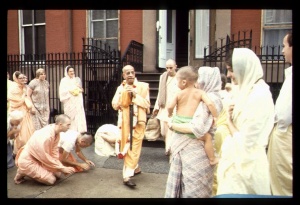CC Adi 7.51 (1975): Difference between revisions
(Vanibot #0027: CCMirror - Mirror CC's 1996 edition to form a basis for 1975) |
(Vanibot #0020: VersionCompareLinker - added a link to the Version Compare feature) |
||
| Line 2: | Line 2: | ||
<div style="float:left">'''[[Sri Caitanya-caritamrta (1975)|Śrī Caitanya-caritāmṛta (1975)]] - [[CC Adi (1975)|Ādi-līlā]] - [[CC Adi 7 (1975)|Chapter 7: Lord Caitanya in Five Features]]'''</div> | <div style="float:left">'''[[Sri Caitanya-caritamrta (1975)|Śrī Caitanya-caritāmṛta (1975)]] - [[CC Adi (1975)|Ādi-līlā]] - [[CC Adi 7 (1975)|Chapter 7: Lord Caitanya in Five Features]]'''</div> | ||
<div style="float:right">[[File:Go-previous.png|link=CC Adi 7.50 (1975)|Ādi-līlā 7.50]] '''[[CC Adi 7.50 (1975)|Ādi-līlā 7.50]] - [[CC Adi 7.52 (1975)|Ādi-līlā 7.52]]''' [[File:Go-next.png|link=CC Adi 7.52 (1975)|Ādi-līlā 7.52]]</div> | <div style="float:right">[[File:Go-previous.png|link=CC Adi 7.50 (1975)|Ādi-līlā 7.50]] '''[[CC Adi 7.50 (1975)|Ādi-līlā 7.50]] - [[CC Adi 7.52 (1975)|Ādi-līlā 7.52]]''' [[File:Go-next.png|link=CC Adi 7.52 (1975)|Ādi-līlā 7.52]]</div> | ||
{{CompareVersions|CC|Adi 7.51|CC 1975|CC 1996}} | |||
{{RandomImage}} | {{RandomImage}} | ||
==== TEXT 51 ==== | ==== TEXT 51 ==== | ||
| Line 25: | Line 24: | ||
<div class="translation"> | <div class="translation"> | ||
"The Māyāvādī sannyāsīs are all criticizing Your Holiness. We cannot tolerate hearing such criticism, for this blasphemy breaks our hearts." | |||
</div> | </div> | ||
| Line 32: | Line 31: | ||
<div class="purport"> | <div class="purport"> | ||
This is a manifestation of real love for Kṛṣṇa and Lord Caitanya Mahāprabhu. There are three categories of Vaiṣṇavas: kaniṣṭha-adhikārīs, madhyama-adhikārīs and uttama-adhikārīs. The kaniṣṭha-adhikārī, or the devotee in the lowest stage of Vaiṣṇava life, has firm faith but is not familiar with the conclusions of the śāstras. The devotee in the second stage, the madhyama-adhikārī, is completely aware of the śāstric conclusion and has firm faith in his guru and the Lord. He, therefore, avoiding nondevotees, preaches to the innocent. However, the mahā-bhāgavata or uttama-adhikārī, the devotee in the highest stage of devotional life, does not see anyone as being against the Vaiṣṇava principles, for he regards everyone as a Vaiṣṇava but himself. This is the essence of Caitanya | This is a manifestation of real love for Kṛṣṇa and Lord Caitanya Mahāprabhu. There are three categories of Vaiṣṇavas: kaniṣṭha-adhikārīs, madhyama-adhikārīs and uttama-adhikārīs. The kaniṣṭha-adhikārī, or the devotee in the lowest stage of Vaiṣṇava life, has firm faith but is not familiar with the conclusions of the śāstras. The devotee in the second stage, the madhyama-adhikārī, is completely aware of the śāstric conclusion and has firm faith in his guru and the Lord. He, therefore, avoiding nondevotees, preaches to the innocent. However, the mahā-bhāgavata or uttama-adhikārī, the devotee in the highest stage of devotional life, does not see anyone as being against the Vaiṣṇava principles, for he regards everyone as a Vaiṣṇava but himself. This is the essence of Caitanya Mahāprabhu's instruction that one be more tolerant than a tree and think oneself lower than the straw in the street (tṛṇād api su-nīcena taror iva sahiṣṇunā). However, even if a devotee is in the uttama-bhāgavata status he must come down to the second status of life, madhyama-adhikārī, to be a preacher, for a preacher should not tolerate blasphemy against another Vaiṣṇava. Although a kaniṣṭha-adhikārī also cannot tolerate such blasphemy, he is not competent to stop it by citing śāstric evidences. Therefore Tapana Miśra and Candraśekhara are understood to be kaniṣṭha-adhikārīs because they could not refute the arguments of the sannyāsīs in Benares. They appealed to Lord Caitanya Mahāprabhu to take action, for they felt that they could not tolerate such criticism although they also could not stop it. | ||
</div> | </div> | ||
Latest revision as of 19:29, 26 January 2020

A.C. Bhaktivedanta Swami Prabhupada
TEXT 51
- tomāre nindaye yata sannyāsīra gaṇa
- śunite nā pāri, phāṭe hṛdaya-śravaṇa
SYNONYMS
tomāre—unto You; nindaye—blasphemes; yata—all; sannyāsīra gaṇa—the Māyāvādī sannyāsīs; śunite—to hear; nā—cannot; pāri—tolerate; phāṭe—it breaks; hṛdaya—our hearts; śravaṇa—while hearing such blasphemy.
TRANSLATION
"The Māyāvādī sannyāsīs are all criticizing Your Holiness. We cannot tolerate hearing such criticism, for this blasphemy breaks our hearts."
PURPORT
This is a manifestation of real love for Kṛṣṇa and Lord Caitanya Mahāprabhu. There are three categories of Vaiṣṇavas: kaniṣṭha-adhikārīs, madhyama-adhikārīs and uttama-adhikārīs. The kaniṣṭha-adhikārī, or the devotee in the lowest stage of Vaiṣṇava life, has firm faith but is not familiar with the conclusions of the śāstras. The devotee in the second stage, the madhyama-adhikārī, is completely aware of the śāstric conclusion and has firm faith in his guru and the Lord. He, therefore, avoiding nondevotees, preaches to the innocent. However, the mahā-bhāgavata or uttama-adhikārī, the devotee in the highest stage of devotional life, does not see anyone as being against the Vaiṣṇava principles, for he regards everyone as a Vaiṣṇava but himself. This is the essence of Caitanya Mahāprabhu's instruction that one be more tolerant than a tree and think oneself lower than the straw in the street (tṛṇād api su-nīcena taror iva sahiṣṇunā). However, even if a devotee is in the uttama-bhāgavata status he must come down to the second status of life, madhyama-adhikārī, to be a preacher, for a preacher should not tolerate blasphemy against another Vaiṣṇava. Although a kaniṣṭha-adhikārī also cannot tolerate such blasphemy, he is not competent to stop it by citing śāstric evidences. Therefore Tapana Miśra and Candraśekhara are understood to be kaniṣṭha-adhikārīs because they could not refute the arguments of the sannyāsīs in Benares. They appealed to Lord Caitanya Mahāprabhu to take action, for they felt that they could not tolerate such criticism although they also could not stop it.